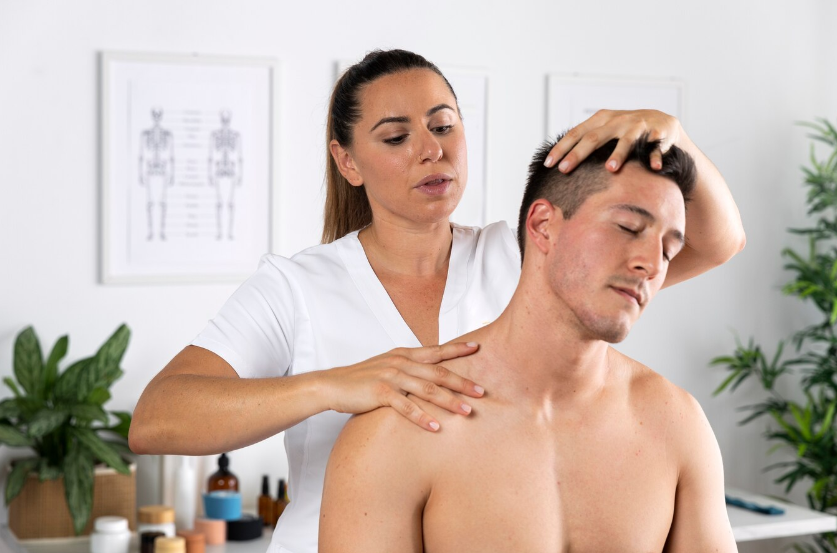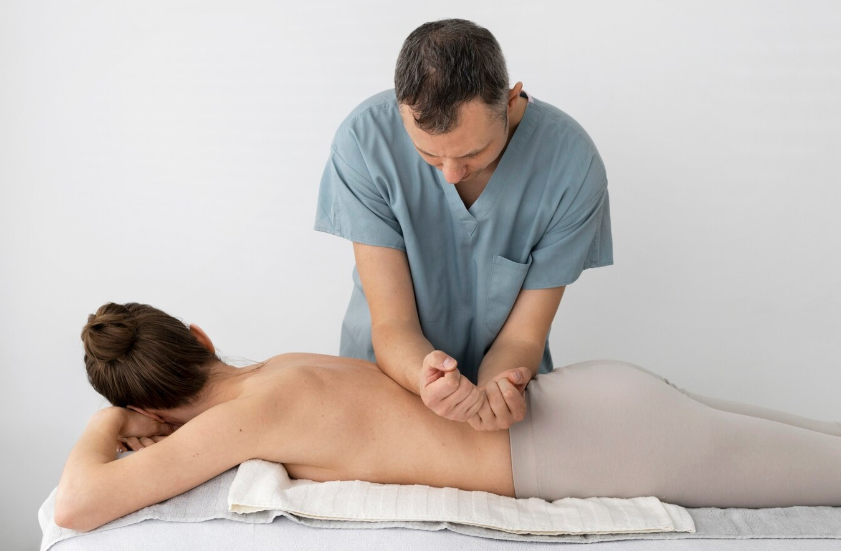Massage therapy has come a long way from being a luxury to becoming a necessity in today’s fast-paced world. Among the various types of massages, there is one technique that continues to stand out due to its unique benefits. Friction massage is a technique that can not only decrease scars but also have other beneficial effects on the body. Specifically, it is a massage technique that can break down adhesions between the tissues such as skin.
One of the many specialized techniques utilized in physical therapy is transverse friction massage, also known as cross fiber massage therapy or cross friction massage. A review of studies found that deep friction massage (DFM) helps people with adhesive capsulitis and plantar fasciitis. More than 200 patients with adhesive capsulitis had less pain and better movement after DFM compared to those who didn’t receive it.
What Exactly is Cross Friction Massage?
Cross friction massage is a specialized form of massage therapy that focuses on the application of pressure and friction across the grain of muscles, tendons, and ligaments. Unlike traditional massage techniques that work along the fibers, cross friction massage moves across them, helping to break down scar tissue and realign collagen fibers, thereby enhancing the overall health of the tissues.
The Anatomy of Scar Tissue and Adhesions
In situations where surgical intervention is necessary due to injuries or orthopedic conditions, the physician will inevitably cause incisions into the skin, tendons, and muscle tissues. Post-operation, once the healing process initiates, scar tissue starts to develop.
Normal, healthy tissue consists of collagen, a substance made up of cells arranged in a regular pattern. This structured arrangement of collagen gives it strength and resilience against tensile forces that occur when tissues undergo pulling and stretching.
However, during the body’s healing process, this collagen arrangement gets disrupted. The body lays down collagen cells haphazardly, leading to the formation of scar tissue. This random collection of collagen cells is tightly packed and reacts adversely to tensile and stretch forces.
Even without surgical intervention, scar tissue can form. For example, muscle or tendon strains can also result in scar tissue formation. The presence of scar tissue can restrict normal motion. Unlike healthy tissue, scar tissue is more rigid, and while some movement may occur, it is more restrictive and less pliable than healthy tissue.
The Role and Goals of Transverse Friction Massage
The primary goals of the transverse friction massage are:
- To break up scarring by mobilizing the affected tissue
- To realign collagen fibers of the tissue
- To increase blood flow to the tissue
- To provide pain relief
- To stimulate nerve fibers to reduce pain and enhance mechanoreceptor activity
The ultimate objective of any physical therapy treatment is to enhance movement and alleviate discomfort. In this regard, the application of a transverse friction massage can prove to be an integral component of the treatment plan.
The Deep Tissue Friction Technique
The deep tissue friction technique involves a set of specific steps. The steps that are adhered to during the treatment process:
- The patient should be comfortable, and the area to be massaged should be exposed.
- If the scar tissue is in a muscle, that muscle should be relaxed. If the scar tissue is in a tendon sheath that tendon should be slightly stretched during the procedure.
- The therapist places two or three fingers over the scar or adhesion.
- The therapist moves their fingers perpendicular (at right angles) to the scar to smooth the collagen fibers down—the fingers and the underlying tissue move together. The massage should feel deep and uncomfortable but not painful.
- The entire area of scar tissue or adhesion should be treated. This may take several minutes.
Contraindications
Despite its numerous benefits, there are certain situations where transverse friction massage is not advisable. These include areas where:
- There is an active open wound
- A bacterial infection is present
- Sensation is decreased
- Calcification is present in the muscle or tendon tissue
- Patients with diminished mental capacity are unable to convey their sensations or pain complaints to the therapist.
Diagnoses Treatable with Transverse Friction Massage

Several diagnoses can be treated with the transverse friction massage. These include adhesive capsulitis in the shoulder (frozen shoulder), joint contracture, scar tissue buildup after surgery or trauma, muscle tears or strains, tendon tears, ligament tears, and tendonitis or tendinopathy.
Benefits of Friction Massage
Friction massage is an old therapeutic technique used since antiquity. This can provide several physical and psychological health advantages. This therapeutic approach is derived from the Latin word “fricare,”. This means “to rub,” which includes applying deep pressure with circular motions, to specific body locations for therapeutic impact. Let’s look at all of its perks!
Pain Relief
Friction massage has been shown to be quite efficient in relieving a variety of discomforts, including muscle soreness, joint inflammation, as well as chronic illnesses such as arthritis. Friction massage reduces pain and speeds up healing by boosting blood flow to damaged regions and alleviating muscular tension.
Improved Circulation
Friction massage has significant benefits compared to other treatment types, particularly in increasing blood circulation. The frictional forces generated by massage strokes between the body and the massage bed surface promote enhanced blood flow to muscles and tissues in need. This improved circulation supplies essential nutrients and oxygen while removing metabolic waste products. The boost in blood flow not only aids healing but also enhances general health and energy.
Break Down Scars
By providing deep pressure, friction massage may be particularly effective in breaking down scar tissue and adhesions caused by injury or surgery. This helps to release tight muscles and fascia, restoring mobility and flexibility to the afflicted regions.
Muscle Relaxation
Friction massage can provide an indescribably peaceful experience by relaxing muscles and increasing the creation of endorphins, our bodies’ natural painkillers. This relaxation reaction reduces stress and anxiety while also improving sleep quality and general well-being.
Increase Joint Motion
Friction massage increases joint range of motion by relaxing tight muscles and enhancing flexibility. This is particularly beneficial while recuperating from an accident or surgery since it restores mobility and function to the damaged regions.
Improve Athletic Performance
Friction massage has long been utilized in an athlete’s training regimen to increase performance and prevent injuries. Friction massage helps athletes recover faster from strenuous exercises while remaining in top physical condition by improving blood flow to muscles, alleviating tension, and promoting flexibility.
Stress Reduction
Friction massage has both physical and psychological advantages, including stress relief. Massage’s rhythmic strokes can create profound relaxation. This reduces stress and promotes general well-being. This comprehensive approach to healing targets both the body and the psyche, resulting in complete balance and harmony.
Lymphatic Drainage
Friction massage may promote lymphatic drainage. This removes toxins and waste from your body, boosts immunity, and improves overall health and vigor.
Scar Reduction
For those with hypertrophic or keloid scars, friction massage may help soften and flatten scar tissue over time. This gradually reduces its appearance. Friction massage helps your body’s natural healing process by boosting circulation and breaking down extra collagen strands while also enhancing the appearance of scars.
Considerations to Find the Best Friction Massage Professionals

Here are some important considerations when choosing a friction massage practitioner:
Qualifications and Credentials
When searching for the best friction massage specialist, double-check their qualifications and credentials. Seek practitioners who have had significant training in friction massage methods; and accreditation from recognized massage therapy organizations. This may help to establish a practitioner’s knowledge and competency.
Experience and expertise
These are other important considerations when hiring a friction massage practitioner. Seek practitioners who have shown effectiveness in doing friction massage, cross fiber massage therapy and also treating a variety of illnesses, including persistent backache. Over time, competent practitioners will have honed their abilities, and gained an intuitive understanding of human bodies and physiology, allowing them to give effective and personalized treatments.
Specialization and focus areas
Friction massage may be used to treat a variety of problems. This includes muscular tension, discomfort, sports injuries, and rehabilitation. When choosing a massage therapist. Make sure they specialize in treating specific issues or have expertise in specific areas that meet your needs. For example, if you are looking for relief from chronic back pain, you can benefit from working with someone who specializes in spinal manipulation techniques and therapeutic massage techniques.
Effective Communication
Effective communication and listening skills are essential in any therapeutic engagement, including friction massage. If you want a pleasant massage session experience that meets all of your health goals and preferences, look for professionals who take the time to listen. Ask relevant questions. Skilled practitioners tailor each massage treatment session to individual client requirements to ensure maximum comfort throughout sessions.
Hygiene and Safety Practices
Hygiene and safety should always be top priorities when seeking massage treatment. Ensure that any friction massage specialist you choose follows stringent hygiene. This includes wholly washing their hands before and after each session using clean linens and equipment, and maintaining a hygienic treatment atmosphere. Inquire about their methods for preventing the transmission of infectious illnesses which many people with existing health difficulties are acutely aware of.
Client Reviews and Testimonials
Research and read customer reviews and testimonials to learn about other people’s experiences with your massage therapist. Look for favorable feedback on quality, professionalism, customer contentment, and any repeating themes. Or patterns that may provide insight into what to anticipate from them.
Cost and Accessibility
While cost should not be the sole issue in choosing a friction massage specialist. It is still essential to consider your budget while making this decision. Compare rates and ask about potential discounts or package packages to ensure you receive the most value for your money. Furthermore, location and accessibility should be considered since they play an essential role in frequent visits and achieving consistent outcomes.
Personal Compatibility
Follow your intuition and examine if you feel comfortable with your friction massage practitioner. Building rapport and trust are critical components of a successful therapeutic relationship. So take the time to determine if they satisfy these requirements before deciding to continue sessions.
Qualifications, experience, expertise, communication skills, hygienic procedures, and client feedback, affordability, accessibility, and personal compatibility are all critical considerations when looking for the best friction massage practitioner. By doing extensive research on all available alternatives, you can guarantee that you get the best possible care and get the most out of friction massage treatments.
Conclusion
Rehabilitation after an injury or surgery can be a challenging process. Working with a physical therapist who uses techniques, such as cross friction massage, combined with appropriate stretches and exercises, can help you regain normal motion and mobility quickly. For more information on massage techniques, check out Spa Utopia, we offer a wide range of therapeutic services.
FAQ
- What is cross friction massage?
Cross friction massage is a physical therapy technique used to minimize the negative impacts of scar tissue in the body.
- What are the goals of transverse friction massage?
The goals include the movement of affected tissue to break up scarring, the realignment of collagen fibers, increasing blood flow to the tissue, relieving pain, and stimulating nerve fibers to decrease pain.
- Who should avoid transverse friction massage?
It should not be used in areas with an active open wound, bacterial infection, decreased sensation, calcification in muscle or tendon tissue, or in patients with diminished mental capacity who can’t report their sensations or pain complaints.
- What conditions can be treated with transverse friction massage?
Conditions like adhesive capsulitis in the shoulder (frozen shoulder), joint contracture, scar tissue buildup after surgery or trauma, muscle tears or strains, tendon tears, ligament tears, and tendonitis or tendinopathy can be treated with this technique.





